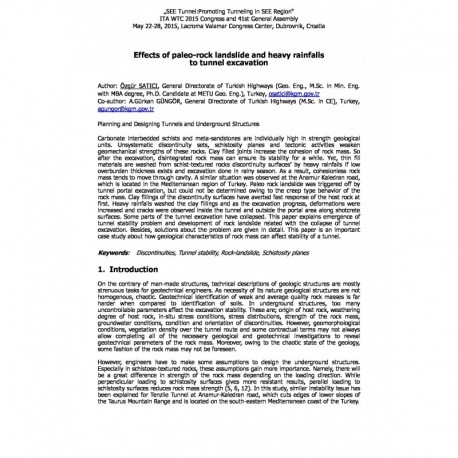Cart
0
0
No document
0,00 €
Total
Document successfully added to your shopping cart
Quantity
Total
There are 0 items in your cart.
There is 1 item in your cart.
Total documents
Total shipping
To be determined
Total
Search & filter
Search for a publication
Search & filter

Effects of paleo-rock landslide and heavy rainfalls to tunnel excavation
wtc2015_full_satici
On the contrary of man-made structures, technical descriptions of geologic structures are mostly strenuous tasks for geotechnical engineers. As necessity of its nature geological structures are not homogenous, chaotic. Geotechnical identification of weak and average quality rock masses is far harder when compared to identification of soils. In underground structures, too many uncontrollable parameters affect the excavation stability. These are; origin of host rock, weathering degree of host rock, in-situ stress conditions, stress distributions, strength of the rock mass, groundwater conditions, condition and orientation of discontinuities. However, geomorphological conditions, vegetation density over the tunnel route and some contractual terms may not always allow completing all of the necessery geological and geotechnical investigations to reveal geotechnical parameters of the rock mass. Moreover, owing to the chaotic state of the geology, some fashion of the rock mass may not be foreseen. However, engineers have to make some assumptions to design the underground structures. Especially in schistose-textured rocks, these assumptions gain more importance. Namely, there will be a great difference in strength of the rock mass depending on the loading direction. While perpendicular loading to schistosity surfaces gives more resistant results, parallel loading to schistosity surfaces reduces rock mass strength (5, 6, 12). In this study, similar instability issue has been explained for Tenzile Tunnel at Anamur-Kaledran road, which cuts edges of lower slopes of the Taurus Mountain Range and is located on the south-eastern Mediterranean coast of the Turkey.


